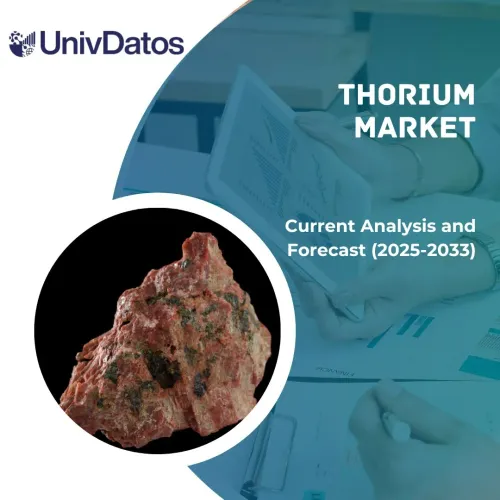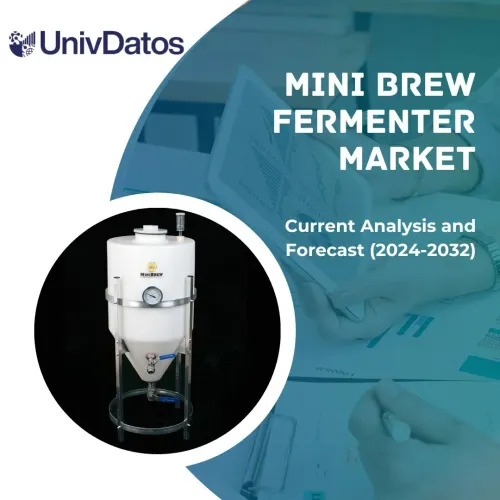- Home
- About Us
- Industry
- Services
- Reading
- Contact Us
Lithium Metal Market: Current Analysis and Forecast (2023-2030)
Emphasis on Type (Hard Rock, and Brine); Application (Batteries, Ceramic & Glass, and Other); Region/Country.
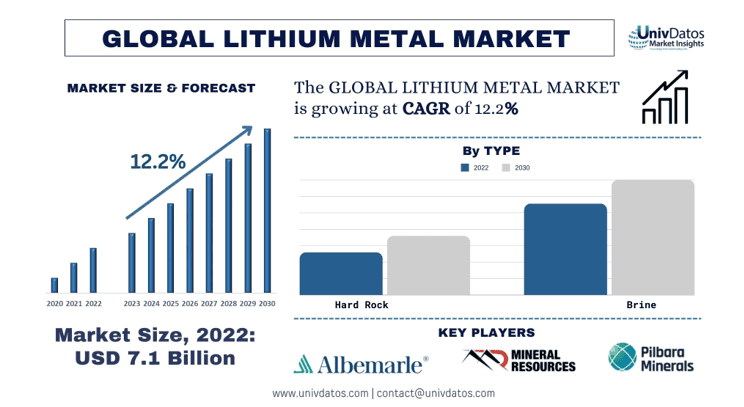
Lithium Metal Market Size and Forecast
The Lithium Metal Market was valued at USD 7,143.2 Million in 2022 and is expected to grow a CAGR of 12.2% during the forecast period (2023-2030). Owing to the rising sales of lithium-based EV Batteries and increasing investment in ceramic & glass products.
Lithium Metal Market Analysis
The Global Lithium Metal Market is experiencing rapid growth, driven by the increasing demand for lithium-ion batteries in electric vehicles (EVs) and energy storage systems. Geographically, Asia Pacific (APAC) holds the largest market share and is expected to exhibit high growth due to increased investment by automotive original equipment manufacturers (OEMs). Factors driving market growth include the rise of EVs, environmental awareness, and technological innovation. The market is characterized by a handful of prominent players, who engage in strategic developments, collaborations, and mergers to remain competitive.
However, numerous challenges face the market including high production costs, safety concerns related to lithium metal’s reactivity, and the risk of supply chain disruption caused by limited natural resources. Despite these issues, the lithium metal market remains integral to the global shift towards sustainability, particularly in the areas of transportation and energy storage.
Some of the major players operating in the market include Albemarle Corp., SQM (Sociedad Química y Minera de Chile), Tianqui Lithium Industries Inc., Ganfeng Lithium Co. Ltd., Mineral Resources Ltd., Pilbara Minerals Ltd., Allkem Ltd., Livent Corp.¸ Sichuan Yahua Industrial Group, and Lithium Americas Corp. Several M&As along with partnerships have been undertaken by these players to facilitate customers with hi-tech and innovative products/technologies.
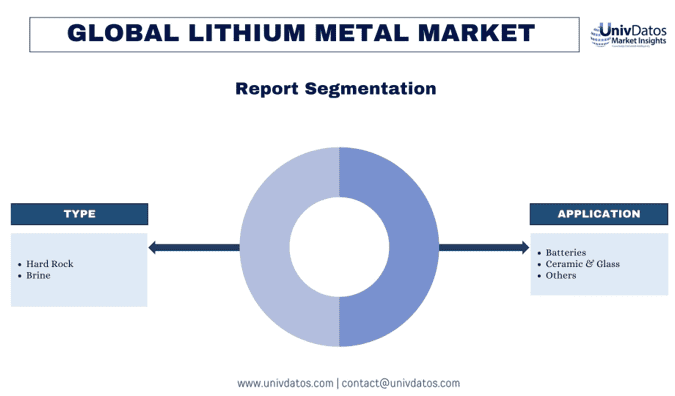
Lithium Metal Market Trends
“Amongst Type, the Brine segment would grow with significant CAGR during the forecast period”
Based on Type, the Lithium Metal Market is bifurcated into Hard Rock and Brine segments. The Hard Rock segment acquired a majority share in the Lithium Metal Market and is expected to register a substantial growth rate during the forecast period. Hard Rock Lithium metals are growing rapidly due to More flexibility, Faster processing, Higher quality, and Comparable costs compared to the brine metal segment. Moreover, the biggest end-user segment of lithium metal is battery manufacturing in which hard rock is preferred due to easier extraction over brine sources. This has caused most major mining companies to focus on expanding their hard rock lithium projects, giving a substantial boost to the hard rock market segment during the forecast period.
“Amongst Application, the Batteries category would grow with significant CAGR during the forecast period”
Based on Application, the Lithium Metal Market is divided into Batteries, Ceramic & Glass, and Others segments. The Batteries segment acquired a majority share in the Lithium Metal Market and is expected to showcase a substantial growth rate during the forecast period. Lithium metal has become a crucial component in the batteries segment due to its unique properties. Lithium-ion batteries are widely used in various applications, including smartphones, laptops, electric vehicles, and renewable energy storage systems. Lithium metal is highly reactive and has a high energy density, making it an ideal material for battery electrodes. It also has a low atomic weight, which means that it can store a large amount of energy in a small volume. However, lithium metal is also highly flammable and can be dangerous if not handled properly. Despite these challenges, the demand for lithium metal in the batteries segment is expected to continue to grow as the world transitions towards a more sustainable and electrified future.
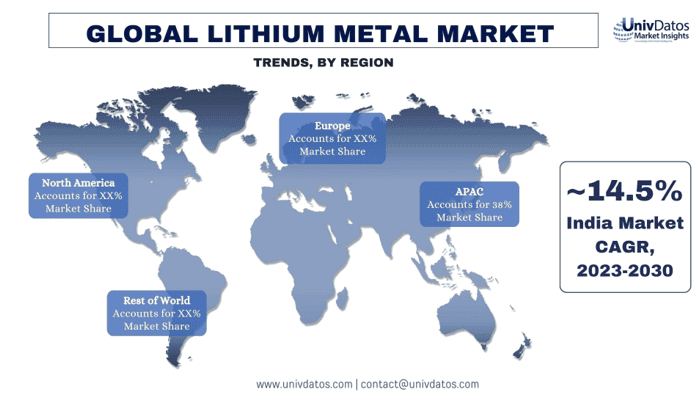
“APAC to grow with high CAGR during the forecast period”
APAC registered the highest market share in the Lithium Metal Market and is expected to witness an influential CAGR in the forecasted period. The Lithium Metal market in the Asia Pacific region is experiencing significant growth, driven by the increasing demand from countries like China, India, Japan, and South Korea. Additionally, the presence of significant OEMs, Lithium producers, and battery device manufacturers in economies like India, China, and Japan is expected to further drive the Lithium Metal market in the Asia Pacific region. The region’s growing population, urbanization, and industrialization have led to a surge in demand for lithium-ion batteries, which are used in electric vehicles and renewable energy storage systems. China is the largest producer and consumer of lithium in the APAC region. The increasing demand for lithium in APAC has led to the development of new lithium mining projects and the expansion of existing ones, making the region a key player in the global lithium market.
Lithium Metal Market Report Coverage
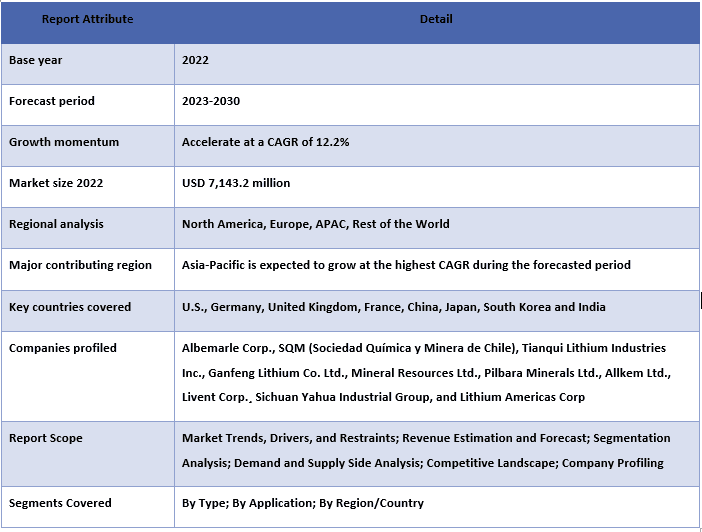
Reasons to buy this report:
- The study includes market sizing and forecasting analysis validated by authenticated key industry experts.
- The report presents a quick review of overall industry performance at one glance.
- The report covers an in-depth analysis of prominent industry peers with a primary focus on key business financials, product portfolios, expansion strategies, and recent developments.
- Detailed examination of drivers, restraints, key trends, and opportunities prevailing in the industry.
- The study comprehensively covers the market across different segments.
- Deep dive regional level analysis of the industry.
Customization Options:
The global Lithium Metal market can further be customized as per the requirement or any other market segment. Besides this, UMI understands that you may have your own business needs, hence feel free to connect with us to get a report that completely suits your requirements.
Table of Content
Research Methodology for the Lithium Metal Market Analysis (2023-2030)
Analyzing the historical market, estimating the current market, and forecasting the future market of the global Lithium Metal market were the three major steps undertaken to create and analyze the adoption of Lithium Metal in major regions globally. Exhaustive secondary research was conducted to collect the historical market numbers and estimate the current market size. Secondly, to validate these insights, numerous findings and assumptions were taken into consideration. Moreover, exhaustive primary interviews were also conducted, with industry experts across the value chain of the global Lithium Metal market. Post assumption and validation of market numbers through primary interviews, we employed a top-down/bottom-up approach to forecasting the complete market size. Thereafter, market breakdown and data triangulation methods were adopted to estimate and analyze the market size of segments and sub-segments of the industry pertains to. Detailed methodology is explained below:
Analysis of Historical Market Size
Step 1: In-Depth Study of Secondary Sources:
Detail secondary study was conducted to obtain the historical market size of the Lithium Metal market through company internal sources such as annual reports & financial statements, performance presentations, press releases, etc., and external sources including journals, news & articles, government publications, competitor publications, sector reports, third-party database, and other credible publications.
Step 2: Market Segmentation:
After obtaining the historical market size of the Lithium Metal market, we conducted a detailed secondary analysis to gather historical market insights and share for different segments & sub-segments for major regions. Major segments are included in the report as Type, and Application. Further country-level analyses were conducted to evaluate the overall adoption of testing models in that region.
Step 3: Factor Analysis:
After acquiring the historical market size of different segments and sub-segments, we conducted a detailed factor analysis to estimate the current market size of the Lithium Metal market. Further, we conducted factor analysis using dependent and independent variables such as Type, and Application of the Lithium Metal market. A thorough analysis was conducted for demand and supply-side scenarios considering top partnerships, mergers and acquisitions, business expansion, and product launches in the Lithium Metal market sector across the globe.
Current Market Size Estimate & Forecast
Current Market Sizing: Based on actionable insights from the above 3 steps, we arrived at the current market size, key players in the global Lithium Metal market, and market shares of the segments. All the required percentage shares split, and market breakdowns were determined using the above-mentioned secondary approach and were verified through primary interviews.
Estimation & Forecasting: For market estimation and forecast, weights were assigned to different factors including drivers & trends, restraints, and opportunities available for the stakeholders. After analyzing these factors, relevant forecasting techniques i.e., the top-down/bottom-up approach were applied to arrive at the market forecast for 2030 for different segments and sub-segments across the major markets globally. The research methodology adopted to estimate the market size encompasses:
- The industry’s market size, in terms of revenue (USD) and the adoption rate of the Lithium Metal market across the major markets domestically
- All percentage shares, splits, and breakdowns of market segments and sub-segments
- Key players in the global Lithium Metal market in terms of products offered. Also, the growth strategies adopted by these players to compete in the fast-growing market
Market Size and Share Validation
Primary Research: In-depth interviews were conducted with the Key Opinion Leaders (KOLs) including Top Level Executives (CXO/VPs, Sales Head, Marketing Head, Operational Head, Regional Head, Country Head, etc.) across major regions. Primary research findings were then summarized, and statistical analysis was performed to prove the stated hypothesis. Inputs from primary research were consolidated with secondary findings, hence turning information into actionable insights.
Split of Primary Participants in Different Regions
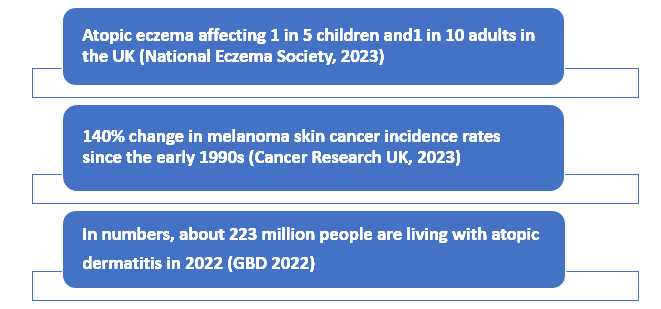
Market Engineering
The data triangulation technique was employed to complete the overall market estimation and to arrive at precise statistical numbers for each segment and sub-segment of the global Lithium Metal market. data was split into several segments & sub-segments post studying various parameters and trends in the areas of the Type, and Application in the global Lithium Metal market.
The main objective of the Global Lithium Metal Market Study
The current & future market trends of the global Lithium Metal market were pinpointed in the study. Investors can gain strategic insights to base their discretion for investments on the qualitative and quantitative analysis performed in the study. Current and future market trends determined the overall attractiveness of the market at a regional level, providing a platform for the industrial participant to exploit the untapped market to benefit from a first-mover advantage. Other quantitative goals of the studies include:
- Analyze the current and forecast market size of the Lithium Metal market in terms of value (USD). Also, analyze the current and forecast market size of different segments and sub-segments
- Segments in the study include areas of the Type, and Application
- Define and analysis of the regulatory framework for the Lithium Metal industry
- Analyze the value chain involved with the presence of various intermediaries, along with analyzing customer and competitor behaviors of the industry
- Analyze the current and forecast market size of the Lithium Metal market for the major region
- Major countries of regions studied in the report include Asia Pacific, Europe, North America, and the Rest of the World
- Company profiles of the Lithium Metal market and the growth strategies adopted by the market players to sustain in the fast-growing market
- Deep dive regional level analysis of the industry
Frequently Asked Questions FAQs
Q1: What is the current market size and growth potential of the global Lithium Metal market?
Q2: What are the driving factors for the growth of the global Lithium Metal Market?
Q3: Which segment has the largest share of the global Lithium Metal market by Type?
Q4: What are the emerging technologies and trends in the global Lithium Metal market?
Q5: Which region will dominate the global Lithium Metal market?
Q6: Who are the key players operating in the global Lithium Metal market?
Related Reports
Customers who bought this item also bought







